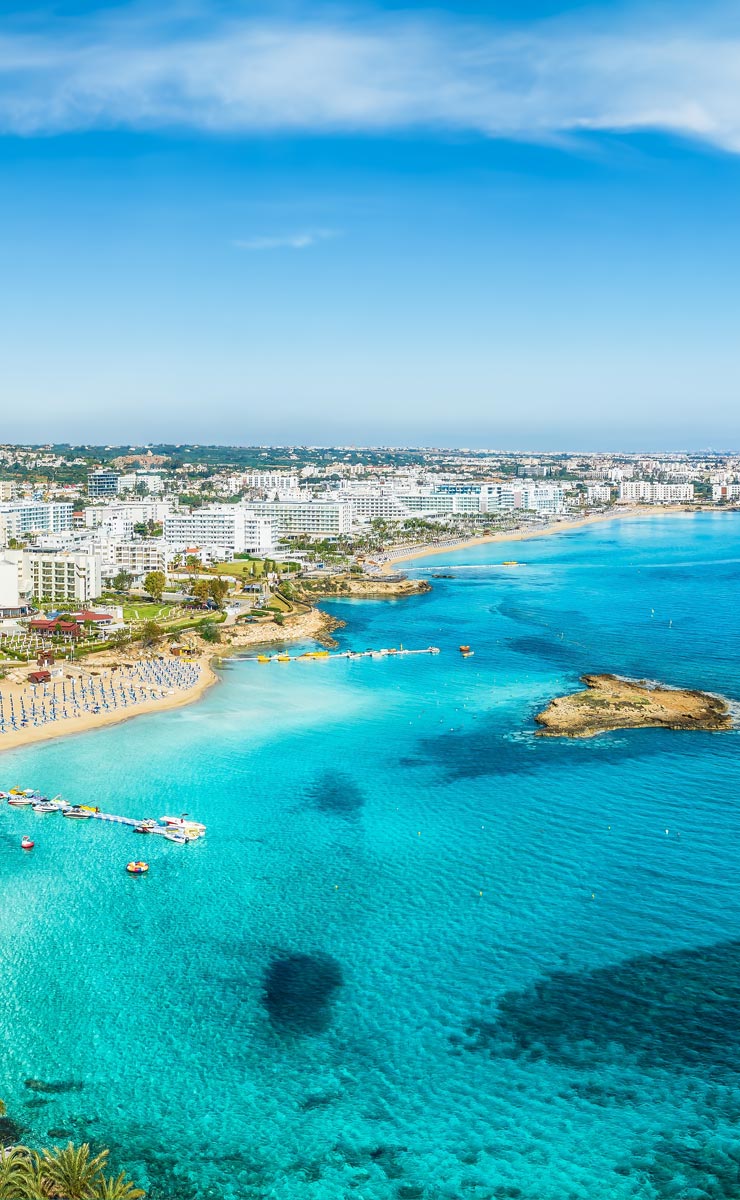If you go as far southeast as you can on Cyprus, you'll find Agia Napa. This resort area is named after a Venetian-era monastery located in the center of Agia Napa village (population 2,700). Called by some visitors "the party capital of the world," Agia Napa is all about pure vacation fun: sun, sand, swimming, sea caves, all night partying, water sports, and the largest water park on Cyprus. Agia Napa is close to Cape Greco, the southeastern most extremity of the island. This headland, part of the greater municipality of Agia Napa, is a protected nature preserve.
The word "napa" is archaic for wooded valley or canyon. The area, which (like most of Cyprus), tends to be dry, and browns up during the summer, was apparently once upon a time more green, with abundant trees. Thus "Agia-" "holy," plus "Napa-" "forest," which equals "Holy Forest." It is referred to in the Iliad, and in some early Christian-era hymns.
The story of the monastery's founding is that a famous icon of the Virgin Mary was found in a local cave, and the monastery was built around the cave at some indeterminate date during the Byzantine era. The present building dates from the 15th century, which was during Venetian rule. The speculation is that the icon was hidden in the cave during the Iconoclast controversy (7-8th centuries) to save it.
In 1790, settlers fleeing a cholera epidemic in Thessaloniki arrived. The area around the monastery has previously been uninhabited. Only one man, Nicholas Kemitzis, and his son survived. Kemitzis re-married a local girl and originally intended to live in her village, which was in the hills above Agia Napa. However, after a dispute with the Ottoman rulers over water rights for the village, Kemitzis moved his family down to the coast, founding the village of Agia Napa.
The Monastery
One of the most unique things about the Agia Napa monastery is that its grounds are in the middle of the village, and are now surrounded by all-night bars and clubs with the attendant revelry that that implies. You can of course flip that perspective around and look at it as an island of peace, quiet, and contemplation, although it is doubtful that the partiers outside the monastery's wall are as bothered by the noise coming from the monastery, as those in the monastery trying to be spiritually contemplative are bothered by the noise coming from outside its walls.
The monastery grounds are oblong in shape, and part of it is cut into the rock of the cave where the icon was found. It is a strongly fortified compound which helped it during the frequent invasions and pirate raids coastal settlements on Cyprus suffered. The monastery's property holdings were very extensive, basically including most of the land of the peninsula on down to Cape Greco.
By the time the British took over Cyprus in 1878, the monastery, which had seen gradual decline over the centuries, was in complete disrepair, and the monks' cells had been empty for a hundred years. Only its church was being used as the village church. In 1950 extensive repairs were started, and the monastery has been fully restored.
Next to the monastery's entrance is a large, 600 year-old sycamore tree said to be built by a young aristocratic woman who came there when it was a convent because of her disobedience. Her experience at the convent was so positive that she funded much of its needs, and planted the tree. Under the tree is a small monument to Greek Noble laureate, the Poet George Seferis, who visited the monastery and composed a poem, "Agianapa," in 1955. It must have been composed on a summer's afternoon, when the wind from the sea picks up as the land cools and releases its heat, because its first stanza says:
Under the aging sycamore
madly the wind was playing
with the birds with the branches
but it never spoke to us.
There is a courtyard in the center of the grounds, surrounded by the various 2-story monastery buildings, built during different time periods out of limestone. In the center of the courtyard is an octagonal enclosure with seats along its inner walls, covered by a stone cupola which is supported by gothic arches. A fountain of water used to come out of an Ionian column in the enclosure's center. A garland, and three faces are carved into 3 the enclosure's 8 outer walls.
In front of one of the 2-story buildings, a working fountain, with water coming out of a Roman-era, stone boar's head, is supplied with water brought from 2km away via the medieval Agia Napa aqueduct (its foundations are much older, dating to the Roman era). The west side of the courtyard contains the church, which, like the monastery, was built piecemeal over the centuries. The interior of the church has two naves of unequal size. In the back of the larger nave a couple steps lead down to the original rock-cut cave- church, where tradition says the icon was found. There are wooden pews, and in front of the church is a wooden iconostasis. The famous icon of the Virgin Mary is in the iconostasis of the much larger church next to the monastery, to the southwest, which was built in 1990.
The Village and its Beaches
The partitioning of Cyprus after the 1974 invasion of the north by Turkey devastated the tourism industry in Cyprus. Agia Napa recovered more rapidly than a lot of other destinations in southern Cyprus. Agia Napa is sort of like a place that's on permanent Spring Break. Clubs open in the late afternoon, and stay open until dawn. The streets after midnight during the high season are full of twenty-somethings in various states of inebriation. Tourists come from all over Europe.
On the other hand, there is plenty to do for families: there is a world-class water park, which we'll talk about later, and all kinds of water sports on the beaches, all of which have earned the EU's Blue Flag designation for cleanliness. In addition to the 4 mentioned below, there are 10 other beaches in the area, for a total of 14, all of which have earned the Blue Flag. Most of them have lifeguards, snack bars warning flags, and nearby toilet facilities. Many have sun beds, umbrellas, and nearby fish taverns.
Harbor Beach (also called Grecian Bay and Glyko Nero), just to the east of Agia Napa's small, charming, heart-shaped harbor, is more of a family-friendly beach. The water is shallow (good for small children), and it is close to everything the village has to offer: food, lodging, and entertainment. It attracts older people, families, and younger people desiring a little quiet.
In contrast, Nissi Beach, about 3km west of the harbor, caters to the young and the young at heart. This 500m-long stretch of sand in a small cove takes its name from the islet just a hundred meters offshore ("nissi" means "island"). The island can be waded to and serves as a nice auxiliary beach for those wanting a little more privacy. BBC Radio One's program "Road Show" broadcasts from Nissi Beach Bar, on the beach's west end, during the summers, greatly increasing its popularity. The beach bar plays non-stop music, and is one of the most popular spots in the whole resort area. The east end is more quiet and family-friendly. It's probably the most popular beach in Cyprus.
At the western extremity of Agia Napa is Makronissos Beach, which is a grouping of 3 coves, the largest and main one being in the center. The beach is frequented by locals, and a mixed bag of tourists, including families with small children, young couples, and singles. At the eastern cove is the Makronissos Beach Club, which has beach parties and concerts all summer long, including the Friday night Kandi Beach Party, billed as Europe's biggest beach party, which features world famous DJs and MCs.
Just a few hundred meters west of Makronissos Beach, and on the same bus line, is the Waterworld water park, billed as the largest themed water park in Europe. Its theme is all things Greek, ancient and mythological. That means you can ride on the River Odyssey, the chariots race (FYI, chariots are Roman, not Greek, but who's counting?), the Poseidon wave pool, the Trojan Adventure, and the Pegasus Children's' Pool. There is the Quest of Hercules, a tower with a double helix-schemed chute wrapping around, Apollo's Plunge, and a columned swimming pool with a zero depth entry and foam toys for small kids. Entrance fee is a bit steep, but it buys you an entire day of fun, and discount tickets can usually be had online.
Konnos Bay Beach is at the eastern end of the municipality of Agia Napa (and close to the southeastern end of Cyprus). It's part of the Cape Greko Nature Preserve. This white sand beach is bookended by headlands and is a favorite of the locals.
A bit further east from Konnos Bay are the scenic sea caves of Cape Greko, which is a fascinating place to swim, scuba dive and snorkel. A lot of adventurous swimmers dive off the cliffs, some of them 15 meters high. This nature preserve is home to over 80 species of birds, and small mammals such as foxes and hedgehogs. The picturesque chapel of Agioi Anargyroi stands on a cliff on the eastern side of the peninsula. This scenic chapel has a barrel roof painted sky blue, and a simple, square-columned concrete porch along all four sides. It's a favorite photo spot for honeymooners and newlyweds. At the tip of the headland there is a lighthouse, in addition to the foundations of a temple to Aphrodite.
By the way, English speakers all pronounce the name "eye-ya nappa." It's a tight little place where you can booze it up, pray, go to the beach, pray some more, party all night, and pray even more. Add to that the interesting rock formations on Cape Greco and the fun at Waterworld, and you have a pretty well all-inclusive holiday.
Best hotels in Cyprus
With a serene beach vibe and approximately 6000 m2 of gardens, the adults-only Leonardo Plaza Cypria Maris Beach Hotel & Spa is a destination for honeymooners
The Grecian Bay is a 5-star hotel near Ayia Napa, Cyprus. Its beach is widely regarded as one of the best in Cyprus, with soft, golden sand, and is fully organized. It is a beautifully landscaped resort with winding pathways and abundant foliage
St. Raphael is a 5-star resort on the south coast of Cyprus, just east of Limassol. Its location is very scenic, with the nice, compact St. Raphael Marina off to one side of the Blue Flag-awarded















